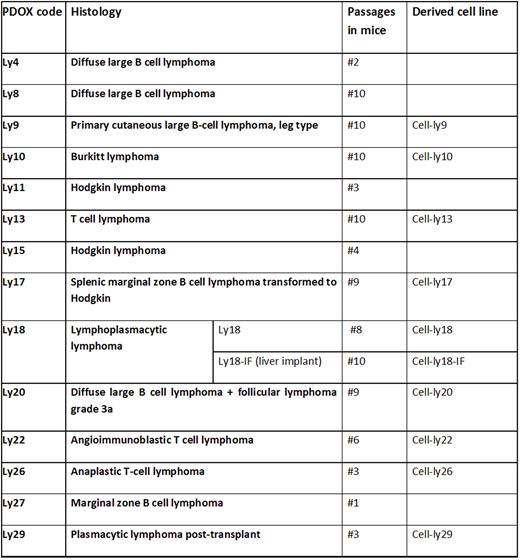Abstract
Introduction: Treatment of relapse/refractory lymphomas has recently improved with the development of novel targeted therapies, immunotherapy and new combinations. However, overcoming therapy resistance is still a main clinical challenge and an overriding priority for patients and treating physicians. Patient-derived orthotopic xenografts (PDOXs), in which a human tumor biopsy is implanted in immunodeficient mice in the same organ as the tumor is grown in the patient, are the most advanced in vivo tumor preclinical models, as they reproduce better patient tumor behavior and therapeutic responses.
Aim: To generate and to characterize PDOXs for refractory and relapsed lymphomas from different histologies and to derive cell lines from these PDOX to obtain advanced preclinical models to delve into the mechanisms involved in drug resistance through therapeutic, mechanistic and functional studies.
Material and Methods: Systematic and prospective study in which a fragment of the patients’ biopsy has been used to generate PDOXs. Fresh tumor biopsies were grafted in spleen and/or mesenteric lymph nodes or in extranodal sites (according to location where tumor grow in the patient), in 1-3 (depending on tissue availability) NOD / LtSz-scid / IL-2Rγchainnull (NSG) mice. Once the tumor grows, the animal was sacrificed and the tumor was re-implanted (2-3 fragments) in the same location in additional animals to expand it for histological, IHQ and molecular characterizations and posterior therapeutic studies. Genetic match between the PDOX and the paired patient tumor from which they derived was assessed using 6 microsatellites by PCR followed by capillary electrophoresis with fluorescence detection. Fusions, point mutations, and expression levels in 125 genes linked to lymphomas were simultaneously detected using Archer® FusionPlex® Lymphoma Kit.
Results: We have generated 15 patient derived xenografts (PDX) based on orthotopic implantation from aggressive B and T cell lymphomas, including resistant DLBCLs, adult Burkitt's lymphoma and aggressive anaplastic and angioimmunoblastic T-cell lymphomas, among other histologies (Table). All of them mimic the histology of the tumor there were derived and showed genetic match with their respective patient tumor. From 10 of these orthotopic PDX, we have derived cell lines to have paired in vitro and in vivo models. These models are now molecularly characterized using a targeted next generation sequencing assay. In vivo massive pharmacologic screening in these models are ongoing.
Conclusions: To our knowledge, these are one of the first orthotopic PDX lymphoma models generated, that can allow us to expand patients’ refractory tumors in order to extensively study molecular features of them and target effective drug profiles.
Disclosures
Eva:TAKEDA: Consultancy, Honoraria, Other: travel and accomodation; BEIGENE: Consultancy; ABBVIE: Other: TRAVEL. Climent:EUSA-Pharma: Speakers Bureau. Gonzalez Barca:TAKEDA: Honoraria; JANSSEN: Consultancy, Honoraria, Other: TRAVEL AND ACCOMODATION; ABBVIE: Consultancy, Honoraria, Other: TRAVEL AND ACCOMODATION; ROCHE: Other: TRAVEL AND ACCOMODATION; KIOWA: Consultancy; BEIGENE: Consultancy; EUSA PHARMA: Consultancy, Honoraria; ASTRAZENECA: Honoraria. Sureda:ROCHE: Consultancy, Honoraria; JANSSEN: Consultancy, Honoraria; TAKEDA: Consultancy, Honoraria, Speakers Bureau; SANOFI: Consultancy, Honoraria; MSD: Honoraria; BMS: Consultancy, Honoraria; NOVARTIS: Consultancy, Honoraria; GILEAD: Consultancy.
Author notes
Asterisk with author names denotes non-ASH members.


This feature is available to Subscribers Only
Sign In or Create an Account Close Modal